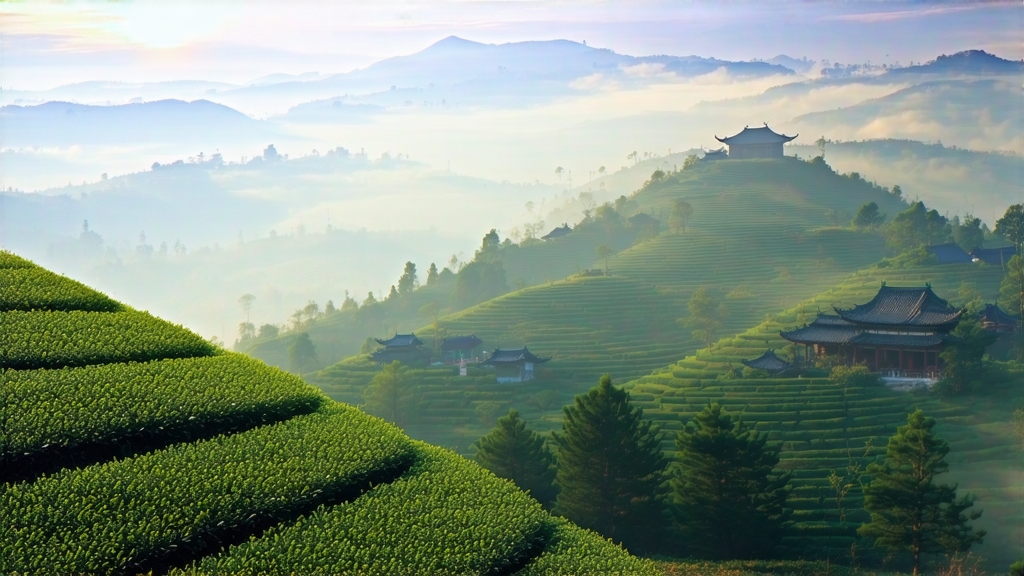
Tucked high on the mist-capped peaks of Sichuan’s Meng Ding Mountain, where clouds brush the evergreen crowns and every breath smells of rain-soaked pine, grows a tea so rare that even seasoned Chinese connoisseurs speak of it in whispers: Meng Ding Huang Ya, literally “Meng Ding Yellow Bud.” Unlike its green cousin Meng Ding Gan Lu, this yellow tea was once carried in silk-lined chests to the Tang-dynasty court, a gift deemed fit for emperors yet nearly erased from living memory during the twentieth century. Today only a few hundred kilograms leave the mountain each spring, most claimed before the leaf even finishes oxidizing. To understand why, one must follow the bud from cloud forest to gaiwan, tracing a craft that turns the simplest of ingredients—one leaf, one bud—into liquid topaz.
History: From Imperial Tribute to Near Extinction
Meng Ding Shan has been sacred to tea since Gan Lu (“Sweet Dew”) was supposedly planted by the Buddhist monk Wu Li Zhen in 53 BCE. Yellow tea’s appearance is harder to date; the first clear record appears in the 8th-century Classic of Tea, where Lu Yu praises “yellowed buds of Meng Ding” for their “jade-yellow liquor and lasting orchid aroma.” By the Song dynasty the tea had become formal tribute, transported by fast horse to Kaifeng along the Jianmen plank road. Imperial demand peaked under the Wanli Emperor (1573–1620), when 560 catties (roughly 340 kg) were levied annually. The Qing continued the tradition, but the chaos of the late 19th century—Taiping rebels, warlord taxes, and the rise of easier green-tea manufacture—broke the chain of master craftsmen. When the People’s Tea Corporation surveyed Meng Ding in 1958, only three old artisans could still execute the secret “men-huang” wrapping step. A state-funded revival followed, yet even now fewer than twenty families possess the full skill set, making every kilogram a time capsule of Tang-era taste.
Micro-Terroir: Where Clouds Act as Shade Cloth
Meng Ding Shan sits at 29.9 °N, 1,450 m above sea level, on the western rim of the Sichuan basin. The mountain traps humid monsoon air against cold Himalayan downdrafts, creating fog on 280 days each year. This natural shade lowers UV-B exposure, forcing the tea bush to synthesize more theanine and fewer bitter catechins. Soils are Devonian sandstone leached by constant mist, yielding a sandy loam so porous that roots dive three metres, mining selenium and rare earths that give the finished tea its tingling minerality. The local cultivar, Sichuan Small-Leaf #9, keeps its buds hairy and tight even at full maturity, ideal for the yellowing process that follows plucking.
Plucking: One Leaf, One Bud, One Dawn
Harvest begins when the mountain azalea blooms—usually between 20 March and 5 April—signalling soil temperature has reached 10 °C. Pickers climb 300-year-old stone staircases before sunrise, wearing woven bamboo hats to keep dew on the leaf; surface moisture is crucial for the enzymatic yellowing that will occur later. Standard is “one leaf, one bud” measuring 2–2.5 cm, snapped with a downward flick that leaves the stem square, not bruised. Any petiole damage turns brown during men-huang and disqualifies the batch. Experienced plkers finish 1 kg of fresh leaf by 9 a.m., enough for 200 g of finished tea.
Craft: The Lost Art of Men-Huang
Yellow tea’s identity rests on a unique “smothering” or men-huang stage that sits between green tea’s kill-green and white tea’s withering. Meng Ding masters divide it into five micro-steps:
- Sha-qing (kill-green) over a 160 °C bamboo tube fire for 90 seconds—just long enough to halt oxidative enzymes while keeping 8 % internal moisture.
- Re-rolling on a 55 °C rattan mat to break surface cells and release grassy volatiles.
- First men-huang: the hot leaf is piled 3 cm deep inside a hemp-lined bamboo basket, covered with wet calico, and left for 40 minutes at 34 °C. Chlorophyll degrades into pheophytin, edges turn